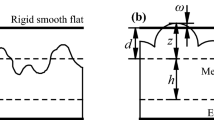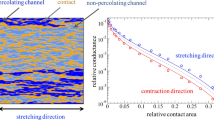Abstract
We revisit the classic problem of an elastic solid with a two-dimensional wavy surface squeezed against an elastic flat half-space from infinitesimal to full contact. Through extensive numerical calculations and analytic derivations, we discover previously overlooked transition regimes. These are seen in particular in the evolution with applied load of the contact area and perimeter, the mean pressure and the probability density of contact pressure. These transitions are correlated with the contact area shape, which is affected by long range elastic interactions. Our analysis has implications for general random rough surfaces, as similar local transitions occur continuously at detached areas or coalescing contact zones. We show that the probability density of null contact pressures is nonzero at full contact. This might suggest revisiting the conditions necessary for applying Persson’s model at partial contacts and guide the comparisons with numerical simulations. We also address the evaluation of the contact perimeter for discrete geometries and the applicability of Westergaard’s solution for three-dimensional geometries.











Similar content being viewed by others
Notes
The nominal contact area is \(A_0=\lambda ^2\) as we carry out our simulations on a surface \(\lambda \times \lambda \) to make use of periodic boundary conditions. In the following, however, due to symmetry, all results will be shown only on a quarter of the simulation domain.
The FFT-based method, which we use, fails to predict accurately the contact area evolution near full contact \(A^{\prime } \gtrapprox 97\,\%\). Thus, to compare with the asymptotic solution near full contact (3), we used a more accurate axisymmetric finite element model with discretization 6,400 points per wavelength (triangles in Fig. 4b).
One can use Ramanujan’s approximation for the perimeter of an ellipse with semi-axes \(a\) and \(b\), \(S\approx \pi (3(a+b)-\sqrt{(3a+b)(a+3b)})\).
See also a discussion in [31].
We found the closure compactness close to the percolation limit to be \(c_{\mathrm{closure}}\approx 4.04\). Regardless the fact that for “closing gap” regime, the shape of the contact boundary cannot be approximated by a square, its compactness measurement near the percolation limit can be with a good accuracy approximated by \(c\approx 4\).
Hereinafter, the PDF of contact pressure is computed only in contact regions; the integral of the PDF over all contact pressures is equal to one.
We recall that in this case, the contact pressure is \(p(r)=p_{\max }\sqrt{1-(r/a)^2}\).
Differentiation under the integral sign: \(\frac{\hbox {d}}{\hbox {d}x}\!\!\!\int \limits _{a(x)}^{b(x)}\!\!\!\!f(x,t)\hbox {d}t = \!f(x,b(x))\frac{\hbox {d}b(x)}{\hbox {d}x} - f(x,a(x))\frac{\hbox {d}a(x)}{\hbox {d}x} + \!\!\!\int \limits _{a(x)}^{b(x)} \!\!\frac{\hbox {d}f(x,t)}{\hbox {d}x}\hbox {d}t\).
References
Bribiesca, E.: Measuring 2-D shape compactness using the contact perimeter. Comput. Math. Appl. 33(11), 1–9 (1997)
Bribiesca, E.: An easy measure of compactness for 2D and 3D shapes. Pattern Recognit. 41(2), 543–554 (2008)
Bush, A.W., Gibson, R.D., Thomas, T.R.: The elastic contact of a rough surface. Wear 35(1), 87–111 (1975)
Carbone, G., Bottiglione, F.: Asperity contact theories: Do they predict linearity between contact area and load? J. Mech. Phys. Solids 56, 2555–2572 (2008)
Dapp, W.B., Lücke, A., Persson, B.N.J., Müser, M.H.: Self-affine elastic contacts: percolation and leakage. Phys. Rev. Lett. 108, 244,301 (2012)
Dieterich, J.H., Kilgore, B.D.: Imaging surface contacts: power law contact distributions and contact stresses in quartz, calcite, glass and acrylic plastic. Tectonophysics 256(1–4), 219–239 (1996)
Dorsey, G., Kuhlmann-Wilsdorf, D.: Metal fiber brushes. In: Slade, P.G. (ed.) Electric Contacts: Principles and Applications, 2nd edn. CRC Press, Boca Raton, FL (2014)
Einzel, D., Panzer, P., Liu, M.: Boundary condition for fluid flow: curved or rough surfaces. Phys. Rev. Lett. 64, 2269–2272 (1990)
Gielis, J.: A generic geometric transformation that unifies a wide range of natural and abstract shapes. Am. J. Bot. 90(3), 333–338 (2003)
Greenwood, J.A.: A simplified elliptic model of rough surface contact. Wear 261, 191–200 (2006)
Greenwood, J.A., Williamson, J.B.P.: Contact of nominally flat surfaces. Proc. R. Soc. Lond. A Math. Phys. Sci. 295, 300–319 (1966)
Hyun, S., Robbins, M.O.: Elastic contact between rough surfaces: effect of roughness at large and small wavelengths. Tribol. Int. 40, 1413–1422 (2007)
Johnson, K., Greenwood, J., Higginson, J.: The contact of elastic regular wavy surfaces. Int. J. Mech. Sci. 27(6), 383–396 (1985)
Johnson, K.L.: Contact Mechanics. Cambridge University Press, Cambridge (1987)
Kalker, J.J.: Variational principles of contact elastostatics. J. Inst. Math. Appl. 20, 199–219 (1977)
Kalker, J.J., van Randen, Y.A.: A minimum principle for frictionless elastic contact with application to non Hertzian problems. J. Eng. Math. 6, 193–206 (1972)
Krithivasan, V., Jackson, R.L.: An analysis of three-dimensional elasto-plastic sinusoidal contact. Tribol. Lett. 27(1), 31–43 (2007)
Manners, W., Greenwood, J.A.: Some observations on Persson’s diffusion theory of elastic contact. Wear 261, 600–610 (2006)
McCool, J.I.: Comparison of models for the contact of rough surfaces. Wear 107(1), 37–60 (1986)
Nayak, P.R.: Random process model of rough surfaces. J. Lubr. Technol. (ASME) 93, 398–407 (1971)
Pastewka, L., Robbins, M.O.: Contact between rough surfaces and a criterion for macroscopic adhesion. Proc. Natl. Acad. Sci. USA 111(9), 3298–3303 (2014)
Persson, B.N.J.: Elastoplastic contact between randomly rough surfaces. Phys. Rev. Lett. 87, 116,101 (2001)
Persson, B.N.J.: Theory of rubber friction and contact mechanics. J. Chem. Phys. 115, 3840–3861 (2001)
Persson, B.N.J., Bucher, F., Chiaia, B.: Elastic contact between randomly rough surfaces: comparison of theory with numerical results. Phys. Rev. B 65, 184,106 (2002)
Stanley, H.M., Kato, T.: An FFT-based method for rough surface contact. J. Tribol-T ASME 119, 481–485 (1997)
Stover, J.C.: Optical Scattering: Measurements and Analysis, 3rd edn. SPIE Press, Bellingham (2012)
Thomas, T.R.: Rough Surfaces, 2nd edn. Imperial College Press, London (1999)
Westergaard, H.M.: Bearing pressures and cracks. J. Appl. Mech. (ASME) 6, 49 (1939)
Yang, C., Persson, B.N.J.: Contact mechanics: contact area and interfacial separation from small contact to full contact. J. Phys.-Condens. Matter 20(21), 215,214+ (2008)
Yastrebov, V.A., Anciaux, G., Molinari, J.F.: Contact between representative rough surfaces. Phys. Rev. E 86(3), 035,601(R) (2012)
Yastrebov, V.A., Anciaux, G., Molinari, J.F.: From infinitesimal to full contact between rough surfaces: evolution of the contact area (2014) arxiv.1401.3800
Acknowledgments
We are grateful to James A. Greenwood and to anonymous reviewers for constructive comments. GA and JFM greatly acknowledge the financial support from the European Research Council (ERCstg UFO-240332).
Author information
Authors and Affiliations
Corresponding author
Appendices
Appendix 1: Probability Density Function of a Wavy Surface
To obtain the PDF of the contact pressure for the case of full contact
we use the following observation. If for a given pressure, we express the iso-pressure curve as \(y=y(x,\tilde{p})\), then the area between two iso-curves \(y(x,\tilde{p})\) and \(y(x,\tilde{p}+\hbox {d}p)\) would be proportional to the increment of the probability density of the contact pressure \(P(\tilde{p},\tilde{p}+\hbox {d}p)\hbox {d}p\) (see Fig. 12
Schematic figure explaining the computation method for the probability density function of a wavy surface. Iso-pressure curves \(y(x,\tilde{p})\) and \(y(x,\tilde{p}+\hbox {d}p)\) at different pressures \(\tilde{p}\), the area between curves is proportional to the probability density increment \(P(\tilde{p},\tilde{p}+\hbox {d}p)\hbox {d}p\)
). At the full contact \(\tilde{p} \in [0,2]\). Then, the iso-pressure curve is given by:
The area under this curve in the range \(x,y\in [0;\lambda /4]\), i.e., for \(\tilde{p}\in [1;2]\) may be expressed as:
The differential of the probability density is then
where \(A_0=\lambda ^2/16\) is the considered area. In the limit \(\hbox {d}p\rightarrow 0\) we obtain
Substituting the integral form (19) in this expression enables us to evaluate this derivative using the differentiation under the integral signFootnote 12
where \({\mathrm{F}}(l,k)=\int \limits _0^l 1/\sqrt{1-k^2\sin ^2(\varphi )}\,\hbox {d}\varphi \) is the incomplete elliptic integral of the first kind. So the probability density of the contact pressure for \(\tilde{p} \in [1;2]\) or equivalently for \(\{x,y\}\in [0;\pi /4]\) is
To extend it to a periodic domain \(x,y\in \mathbb R\) and for \(\tilde{p}\in [0;2]\), one needs simply to take the absolute value of the argument in \(\arccos \) and divide the PDF by a factor of two
This expression is depicted in Fig. 13 and compared with numerically evaluated probability density of a wavy surface computed on the grid of \(2\times 10^8\) equally spaced points in the region \(\{x,y\}\in [0;\pi /4]\) using 500 bins.
Comparison of the analytically evaluated (21) and numerically evaluated (\(2\times 10^8\) grid points per \(\lambda /4\times \lambda /4\) and 500 bins) probability density function of a wavy surface
Appendix 2: Data
In Table 1 some numerical results are presented (pressure, area and perimeter) as well as coefficients of Gielis formula (5) that fit the corresponding area shape.
Rights and permissions
About this article
Cite this article
Yastrebov, V.A., Anciaux, G. & Molinari, JF. The Contact of Elastic Regular Wavy Surfaces Revisited. Tribol Lett 56, 171–183 (2014). https://doi.org/10.1007/s11249-014-0395-z
Received:
Accepted:
Published:
Issue Date:
DOI: https://doi.org/10.1007/s11249-014-0395-z






